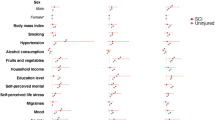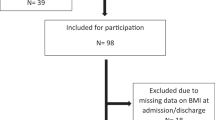Abstract
Study design
Secondary analysis of cross-sectional data from the ALLRISC cohort study.
Objectives
To investigate the prevalence of obesity and its association with time since injury (TSI) and physical activity (PA) in wheelchair users with long-standing (TSI > 10 years) spinal cord injury (SCI).
Setting
Community, The Netherlands.
Methods
Wheelchair users with SCI (N = 282) in TSI strata (10–19, 20–29, and ≥30 years) and divided in meeting SCI-specific exercise guidelines or not. Waist circumference (WC) and body mass index (BMI) were assessed. Participants were classified as being obese (WC > 102 cm for men, WC > 88 cm for women; BMI ≥ 25 kg/m2) or not. Logistic regression analyses were performed to investigate the associations between obesity and TSI and PA.
Results
Almost half of the participants (45–47%) were classified as obese. TSI was significantly associated with obesity, the odds of being obese were 1.4 higher when having a 10 years longer TSI. Furthermore, the odds of being obese were 2.0 lower for participants who were meeting the exercise guidelines.
Conclusions
The prevalence of obesity is high in people with long-standing SCI. Those with a longer TSI and individuals who do not meet the exercise guidelines are more likely to be obese and need to be targeted for weight management interventions.
This is a preview of subscription content, access via your institution
Access options
Subscribe to this journal
Receive 12 print issues and online access
$259.00 per year
only $21.58 per issue
Buy this article
- Purchase on Springer Link
- Instant access to full article PDF
Prices may be subject to local taxes which are calculated during checkout


Similar content being viewed by others
Data availability
Data are available from the corresponding author on reasonable request.
References
Elsner JJ, Gefen A. Is obesity a risk factor for deep tissue injury in patients with spinal cord injury? J Biomech. 2008;41:3322–31.
Ravensbergen HR, Lear SA, Claydon VE. Waist circumference is the best index for obesity-related cardiovascular disease risk in individuals with spinal cord injury. J Neurotrauma. 2014;31:292–300.
Wen H, DeVivo MJ, Mehta T, Kaur Baidwan N, Chen Y. The impact of body mass index on one-year mortality after spinal cord injury. J Spinal Cord Med. 2021;44:563–71.
de Groot S, Post MW, Postma K, Sluis TA, van der Woude LH. Prospective analysis of body mass index during and up to 5 years after discharge from inpatient spinal cord injury rehabilitation. J Rehabil Med. 2010;42:922–8.
Ma Y, de Groot S, Romviel S, Achterberg W, van Orsouw L, Janssen TWJ. Changes in body composition during and after inpatient rehabilitation in people with recent spinal cord injury. Spinal Cord Ser Cases. 2021;7:88.
Crane DA, Little JW, Burns SP. Weight gain following spinal cord injury: a pilot study. J Spinal Cord Med. 2011;34:227–32.
Hatchett PE, Mulroy SJ, Eberly VJ, Haubert LL, Requejo PS. Body mass index changes over 3 years and effect of obesity on community mobility for persons with chronic spinal cord injury. J Spinal Cord Med. 2016;39:421–32.
Wen H, Chen Y, He Y, Bickel CS, Robinson-Whelen S, Heinemann AW. Racial Differences in Weight Gain: A 5-Year Longitudinal Study of Persons With Spinal Cord Injury. Arch Phys Med Rehabil. 2018;99:1957–64.
Holm NJ, Steensgaard R, Schou LH, Møller T, Kasch H, Biering-Sørensen F. An observational study on body mass index during rehabilitation and follow-up in people with spinal cord injury in Denmark. Spinal Cord. 2022;60:157–62.
Buchholz AC, Horrocks J, Martin Ginis KA, Bray SR, Craven BC, Hicks AL, et al. Changes in traditional chronic disease risk factors over time and their relationship with leisure-time physical activity in people living with spinal cord injury. Appl Physiol Nutr Metab. 2012;37:1072–9.
Powell D, Affuso O, Chen Y. Weight change after spinal cord injury. J Spinal Cord Med. 2017;40:130–7.
Gupta N, White KT, Sandford PR. Body mass index in spinal cord injury—a retrospective study. Spinal Cord. 2006;44:92–4.
D’Oliveira GL, Figueiredo FA, Passos MC, Chain A, Bezerra FF, Koury JC. Physical exercise is associated with better fat mass distribution and lower insulin resistance in spinal cord injured individuals. J Spinal Cord Med. 2014;37:79–84.
Jörgensen S, Svedevall S, Magnusson L, Martin Ginis KA, Lexell J. Associations between leisure time physical activity and cardiovascular risk factors among older adults with long-term spinal cord injury. Spinal Cord. 2019;57:427–33.
Buchholz AC, Martin Ginis KA, Bray SR, Craven BC, Hicks AL, Hayes KC, et al. Greater daily leisure time physical activity is associated with lower chronic disease risk in adults with spinal cord injury. Appl Physiol Nutr Metab. 2009;34:640–7.
Raguindin PF, Stoyanov J, Eriks-Hoogland I, Stucki G, Jordan X, Schubert M, et al. Cardiometabolic risk profiling during spinal cord injury rehabilitation: a longitudinal analysis from the Swiss Spinal Cord Injury (SwiSCI) cohort. PM R. 2023;15:715–30.
Buchholz AC, Bugaresti JM. A review of body mass index and waist circumference as markers of obesity and coronary heart disease risk in persons with chronic spinal cord injury. Spinal Cord. 2005;43:513–8.
Adriaansen JJ, van Asbeck FW, Lindeman E, van der Woude LH, de Groot S, Post MW. Secondary health conditions in persons with a spinal cord injury for at least 10 years: design of a comprehensive long-term cross-sectional study. Disabil Rehabil. 2013;35:1104–10.
Laughton GE, Buchholz AC, Martin Ginis KA, Goy RE. Lowering body mass index cutoffs better identifies obese persons with spinal cord injury. Spinal Cord. 2009;47:757–62.
Grundy SM, Brewer HB Jr, Cleeman JI, Smith SC Jr, Lenfant C. Definition of metabolic syndrome: report of the National Heart, Lung, and Blood Institute/American Heart Association conference on scientific issues related to definition. Circulation. 2004;109:433–8.
Washburn RA, Zhu W, McAuley E, Frogley M, Figoni SF. The physical activity scale for individuals with physical disabilities: development and evaluation. Arch Phys Med Rehabil. 2002;83:193–200.
Hoevenaars D, Holla JFM, Postma K, van der Woude LHV, Janssen TWJ, de Groot S. Associations between meeting exercise guidelines, physical fitness, and health in people with spinal cord injury. Disabil Rehabil. 2023;45:1030–7.
Martin Ginis KA, van der Scheer JW, Latimer-Cheung AE, Barrow A, Bourne C, Carruthers P, et al. Evidence-based scientific exercise guidelines for adults with spinal cord injury: an update and a new guideline. Spinal Cord. 2018;56:308–21.
Blokstra A, Vissink P, Venmans LMAJ, Holleman P, van der Schouw YT, Smit HA, et al. Nederland de Maat Genomen, 2009–2010: monitoring van risicofactoren in de algemene bevolking. Bilthoven, the Netherlands: Rijksinstituut voor Volksgezondheiden Milieu; 2011.
Edwards LA, Bugaresti JM, Buchholz AC. Visceral adipose tissue and the ratio of visceral to subcutaneous adipose tissue are greater in adults with than in those without spinal cord injury, despite matching waist circumferences. Am J Clin Nutr. 2008;87:600–7.
Singh R, Rohilla RK, Saini G, Kaur K. Longitudinal study of body composition in spinal cord injury patients. Indian J Orthop. 2014;48:168–77.
van den Berg-Emons RJ, Bussmann JB, Haisma JA, Sluis TA, van der Woude LH, Bergen MP, et al. A prospective study on physical activity levels after spinal cord injury during inpatient rehabilitation and the year after discharge. Arch Phys Med Rehabil. 2008;89:2094–101.
Felleiter P, Krebs J, Haeberli Y, Schmid W, Tesini S, Perret C. Post-traumatic changes in energy expenditure and body composition in patients with acute spinal cord injury. J Rehabil Med. 2017;49:579–84.
Koury JC, Passos MC, Figueiredo FA, Chain A, Franco JG. Time of physical exercise practice after injury in cervical spinal cord-injured men is related to the increase in insulin sensitivity. Spinal Cord. 2013;51:116–9.
Gonze BB, Lopes Valentim Di Paschoale Ostolin T, Sperandio EF, Arantes RL, Romiti M, Dourado VZ. Effects of substituting sedentary behavior with light-intensity or moderate-to-vigorous physical activity on obesity indices in adults: a prospective short-term follow-up study. Int J Environ Res Public Health. 2021;18:13335.
Watson PK, Arora M, Middleton JW, Quel de Oliveira C, Heard R, Nunn A, et al. Leisure-time physical activity in people with spinal cord injury-predictors of exercise guideline adherence. Int J Public Health. 2022;67:1605235.
Garshick E, Ashba J, Tun CG, Lieberman SL, Brown R. Assessment of stature in spinal cord injury. J Spinal Cord Med. 1997;20:36–42.
Acknowledgements
This research collaboration is only possible with the strong involvement of eight SCI-specialized rehabilitation centers in the Netherlands and their dedicated physiatrists, research assistants, organizations and management: Heliomare (Wijk aan Zee), St Maartenskliniek (Nijmegen),‘tRoessingh (Enschede), Rijndam/EUR (Rotterdam), Reade (Amsterdam), De Hoogstraat (Utrecht), Adelante (Hoensbroek) and UMCG Centre for Rehabilitation, Location Beatrixoord (Haren).
Funding
ALLRISC is sponsored by “Fonds NutsOHRA” under the responsibility of the Netherlands Organisation for Health Research and Development (www.ZonMw.nl), Project number 89000006.
Author information
Authors and Affiliations
Contributions
SdeG analyzed the data and wrote the final manuscript. JJEA wrote the study protocol, coordinated the data collection, and provided feedback on the manuscript. JMSS and RO contributed to the data collection and provided feedback on the manuscript. RJGBE provided feedback on the manuscript. MWMP obtained funding for the study and provided feedback on the manuscript.
Corresponding author
Ethics declarations
Competing interests
The authors declare no competing interests.
Ethics approval
The research protocol was approved by the Medical Ethics Committee of the University Medical Center Utrecht (protocol number 11–156/E; NL36394.041.11, version 4). We certify that all applicable institutional and governmental regulations concerning the ethical use of human volunteers were followed during the course of this research.
Additional information
Publisher’s note Springer Nature remains neutral with regard to jurisdictional claims in published maps and institutional affiliations.
Rights and permissions
Springer Nature or its licensor (e.g. a society or other partner) holds exclusive rights to this article under a publishing agreement with the author(s) or other rightsholder(s); author self-archiving of the accepted manuscript version of this article is solely governed by the terms of such publishing agreement and applicable law.
About this article
Cite this article
de Groot, S., Adriaansen, J.J.E., Stolwijk-Swüste, J.M. et al. Obesity in wheelchair users with long-standing spinal cord injury: prevalence and associations with time since injury and physical activity. Spinal Cord (2024). https://doi.org/10.1038/s41393-024-00995-6
Received:
Revised:
Accepted:
Published:
DOI: https://doi.org/10.1038/s41393-024-00995-6



